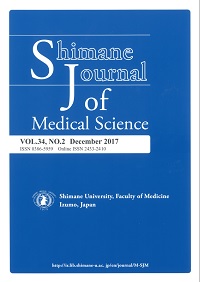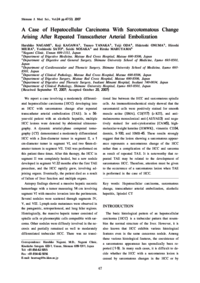Shimane University Faculty of Medicine
ISSN :0386-5959(in print)
ISSN :2433-2410(online)


These article are licensed under a Creative Commons Attribution-NonCommercial-NoDerivatives 4.0 International License.
number of downloads : ?
Use this link to cite this item : https://ir.lib.shimane-u.ac.jp/6569
Shimane Journal of Medical Science 24
2007-12-01 発行
A case of hepatocellular carcinoma with sarcotomatous change arizing after repeated transcatheter arterial embolization
Nagami, Haruhiko
Kagawa, Koji
Tanaka, Tsuneo
Onuma, Hidetoshi
Sato, Yoshitoshi
Nosaka, Seishi
File
Description
We report a case involving a moderately differentiated hepatocellular carcinoma (HCC) developing into an HCC with sarcomatous change after repeated transcatheter arterial embolization (TAE). In a 56-year-old patient with an alcoholic hepatitis, multiple HCC Iesions were detected by abdominal ultrasonography. A dynamic arterial-phase computed tomography (CT) demonstrated a moderately differentiated HCC with a 2cm-diameter tumor in segment II, a 1cm-diameter tumor in segment VI, and two 6mm-di-ameter tumors in segment VII. TAE was performed on this patient three times. After this therapy, the HCC in segment ll was completely healed, but a new nodule developed in segment VI 22 months after the first TAE procedure, and the HCC rapidly grew, involving adjoining organs. Eventually, the patient died as a result of failure of liver function and multiple organs.
Autopsy findings showed a massive hepatic necrotic hemorrhage with a tumor measuring 14 cm involving segment V1 with massive invasion into the peritoneum. Several nodules were scattered through segments IV, V, and VIII. Lymph node metastases were observed in the paragastric, retroperitoneal, and lung hilar regions Histologically, the massive hepatic tumor consisted of spindle cells or pleomorphic cells compatible with sarcoma. Other nodules were diffusely involved in the necrosis and partiully remained as well to moderately differentiated trabecu]ar HCC. There was no transi-tional line between the HCC and sarcomatous spindle cells An immunohistcchemical study showed that the sarcomatoid ce]Is were positively stained for smooth muscle actine (SMA), CD(ll7) (c-KIT), and anti-melanosoma monoclonical anti-(AEl/AE3) and nega-tively stained for anti-cytolceratine (CAM5), high-molecular-weight keratine (HMWK), vimentin CD34, desmin, S-lOO, and HMB-45. These results strongiy suggest that the lesion showing a sarcomatous appearance represents a sarcomatous change of the HCC rather than a complication of the HCC and sarcoma as result of repeated TAE. It is noteworthy that repeated TAE may be related to the development of sarcomatous HCC. Therefore, attention must be given to the occurrence of a sarcomatous lesion when TAE is performed in the case of HCC.
Autopsy findings showed a massive hepatic necrotic hemorrhage with a tumor measuring 14 cm involving segment V1 with massive invasion into the peritoneum. Several nodules were scattered through segments IV, V, and VIII. Lymph node metastases were observed in the paragastric, retroperitoneal, and lung hilar regions Histologically, the massive hepatic tumor consisted of spindle cells or pleomorphic cells compatible with sarcoma. Other nodules were diffusely involved in the necrosis and partiully remained as well to moderately differentiated trabecu]ar HCC. There was no transi-tional line between the HCC and sarcomatous spindle cells An immunohistcchemical study showed that the sarcomatoid ce]Is were positively stained for smooth muscle actine (SMA), CD(ll7) (c-KIT), and anti-melanosoma monoclonical anti-(AEl/AE3) and nega-tively stained for anti-cytolceratine (CAM5), high-molecular-weight keratine (HMWK), vimentin CD34, desmin, S-lOO, and HMB-45. These results strongiy suggest that the lesion showing a sarcomatous appearance represents a sarcomatous change of the HCC rather than a complication of the HCC and sarcoma as result of repeated TAE. It is noteworthy that repeated TAE may be related to the development of sarcomatous HCC. Therefore, attention must be given to the occurrence of a sarcomatous lesion when TAE is performed in the case of HCC.
About This Article
Other Article
PP. 7 - 13
PP. 29 - 35
PP. 43 - 46
